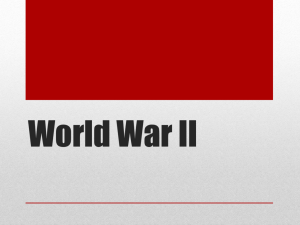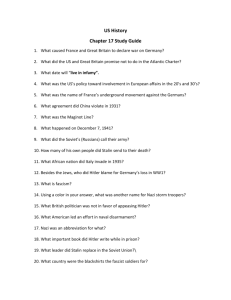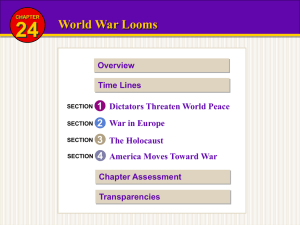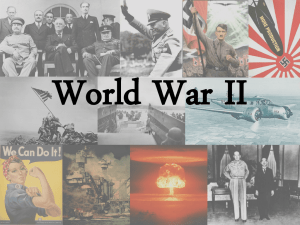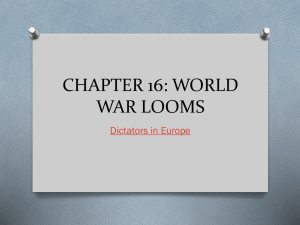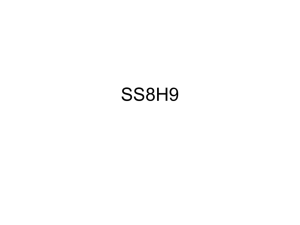File
advertisement
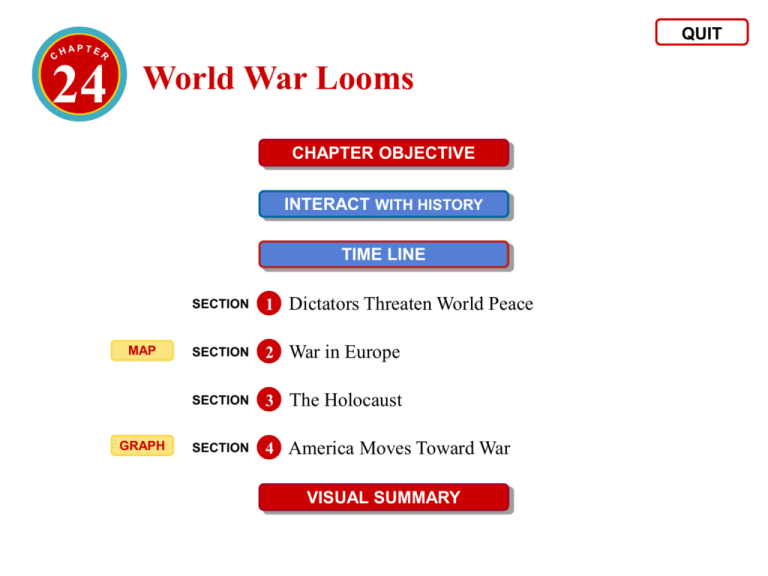
QUIT 24 World War Looms CHAPTER OBJECTIVE INTERACT WITH HISTORY TIME LINE MAP GRAPH SECTION 1 Dictators Threaten World Peace SECTION 2 War in Europe SECTION 3 The Holocaust SECTION 4 America Moves Toward War VISUAL SUMMARY HOME 24 World War Looms CHAPTER OBJECTIVE To trace the rise of dictators, the beginnings of war, and the American response in the 1930s HOME 24 World War Looms INTERACT WITH HISTORY In the summer of 1939, President Franklin Roosevelt addresses an anxious nation in response to atrocities in Europe committed by Hitler’s Nazi Germany. Roosevelt declares in his broadcast that the United States “will remain a neutral nation.” He acknowledges, however, that he “cannot ask that every American remain neutral in thought.” Why might the United States try to remain neutral? Examine the Issues • How might involvement in a large scale war influence the United States? • How can neutral countries participate in the affairs of warring countries? HOME 24 World War Looms TIME LINE The United States The World 1931 The Empire State Building opens in New York City. 1931 Japan conquers Manchuria, in northern China. 1932 Franklin Delano Roosevelt is elected president. 1933 Prohibition ends. 1933 Adolf Hitler is appointed German chancellor and sets up Dachau concentration camp. 1934 Stalin begins great purge in USSR. Chinese communists flee in the Long March. 1936 Jesse Owens wins four gold medals at Olympics in Berlin, Germany. Roosevelt is reelected. 1936 Ethiopia’s Haile Selassie asks League of Nations for help against Italian invasion. General Francisco Franco leads a fascist rebellion in Spain. 1937 Amelia Earhart mysteriously disappears attempting solo round-the-world flight. continued . . . HOME 24 World War Looms TIME LINE The United States The World 1938 Orson Welles broadcasts The War of the Worlds, a fictional alien invasion. 1938 Kristallnacht—Nazis riot, destroying Jewish neighborhoods. 1939 Germany invades Poland. Britain and France declare war. 1940 Roosevelt is elected to a third term. 1941 United States enters World War II. 1941 Japan bombs Pearl Harbor. HOME 1 Dictators Threaten World Peace KEY IDEA The United States remains isolated from world affairs as economic and political factors lead to the rise of nationalist leaders in the Soviet Union, Germany, and Italy. OVERVIEW ASSESSMENT HOME 1 Dictators Threaten World Peace OVERVIEW MAIN IDEA WHY IT MATTERS NOW The rise of rulers with total power in Europe and Asia led to World War II. Dictators of the 1930s and 1940s changed the course of history, making world leaders especially watchful for the actions of dictators today. TERMS & NAMES • Joseph Stalin • fascism • Benito Mussolini • Adolf Hitler • Nazism • Francisco Franco • Neutrality Acts • totalitarian ASSESSMENT HOME 1 Dictators Threaten World Peace ASSESSMENT 1. Identify the main ambitions of each dictator listed in the web diagram. Stalin: Create a model Communist state and transform the Soviet Union into a great industrial power Dictator’s Ambitions Hitler: Unite the German “master race” into an empire destined to rule the world Mussolini: Franco: Make Italy a great world power Become Spain’s supreme military leader continued . . . HOME 1 Dictators Threaten World Peace ASSESSMENT 2. How did the Treaty of Versailles sow the seeds of instability in Europe? Think About: • effects of the treaty on Germany and the Soviet Union • effects of the treaty on national pride • the economic legacy of the war ANSWER Germany and the Soviet Union’s resentment of the treaty contributed to their renunciation of democratic values. The treaty did little to halt the rise of totalitarian governments. continued . . . HOME 1 Dictators Threaten World Peace ASSESSMENT 3. Why do you think Hitler found widespread support among the German people? ANSWER Germany was devastated by the effects of World War I. The nation suffered from severe economic depression. Hitler promoted the Nazi party as a way to restore national pride. continued . . . 1 HOME Dictators Threaten World Peace ASSESSMENT 4. Would powerful nations or weak nations be more likely to follow an isolationist policy? Explain. ANSWER Strong, self-sufficient nations can afford to adopt isolationist policies. Weaker nations are often too dependent on foreign powers. End of Section 1 HOME MAP 2 War in Europe KEY IDEA A series of bold moves by Adolf Hitler—and weak countermoves by other leaders— triggers World War II in Europe. OVERVIEW ASSESSMENT HOME MAP 2 War in Europe OVERVIEW MAIN IDEA WHY IT MATTERS NOW Using the sudden mass attack called blitzkrieg, Germany invaded and quickly conquered many European countries. Hitler’s actions started World War II and still serve as a warning to be vigilant about totalitarian government. TERMS & NAMES • Charles de Gaulle • blitzkrieg • nonaggression pact • Winston Churchill • appeasement • Neville Chamberlain ASSESSMENT HOME MAP 2 War in Europe ASSESSMENT 1. Trace the movement of German expansion from 1937 to the end of 1940 by supplying events to follow the dates shown on the time line. 1937 1939 Hitler plans expansion. World War II begins after Germany invades Poland. 1938 1940 Germany annexes Austria and Sudetenland. Germany invades France and fights the Battle of Britain with England. continued . . . MAP 2 HOME War in Europe ASSESSMENT 2. To what extent do you think lies and deception played a role in Hitler’s tactics? Think About: • William Shirer’s diary entry about headlines in the Nazi newspapers • Soviet-German relations • Hitler’s justifications for military aggression ANSWER Hitler’s deceptions included: charging the Czechs with abusing Sudeten Germans; claiming that Sudetenland was his last territorial demand; accusing Poles of brutalizing Germans; signing a secret pact with the Soviet Union dividing Poland; justifying the invasion of Denmark and Norway as necessary to safeguard his plans. continued . . . MAP 2 HOME War in Europe ASSESSMENT 3. If you had been a member of the British House of Commons in 1938, would you have voted for or against the Munich Agreement? ANSWER POSSIBLE RESPONSES: For: Appeasement would help avert war; compromise is not a sign of weakness. Against: Appeasement would feed Hitler’s military aggression; Great Britain should defend its honor and declare war. continued . . . MAP 2 HOME War in Europe ASSESSMENT 4. Review Germany’s aggressive actions between 1938 and 1945. At what point do you think Hitler concluded that he could take any territory without being stopped? ANSWER POSSIBLE RESPONSES: After taking Austria—France and Britain ignored their pledge to protect Austria. After Munich Conference—Britain and France let Germany take Sudetenland. End of Section 2 HOME 3 The Holocaust KEY IDEA Hitler’s plans for conquering the world include the killing of Jews and other ethnic groups, which is carried out with frightening determination. OVERVIEW ASSESSMENT HOME 3 The Holocaust OVERVIEW MAIN IDEA WHY IT MATTERS NOW During the Holocaust, the Nazis systematically executed 6 million Jews and 5 million other “non-Aryans.” After the atrocities of the Holocaust, agencies formed to publicize human rights. These agencies have remained a force in today’s world. TERMS & NAMES • Holocaust • ghetto • Kristallnacht • genocide • concentration camp ASSESSMENT HOME 3 The Holocaust ASSESSMENT 1. List four events that led to the Holocaust. Causes Effect The removal of non-Aryans from government jobs. Nuremberg Laws The Holocaust Kristallnacht “Final Solution” continued . . . 3 HOME The Holocaust ASSESSMENT 2. Do you think that the United States was justified in not allowing more Jewish refugees to emigrate? Think About: • the views of isolationists in the United States • some Americans’ prejudices and fears • the incident on the German luxury liner St. Louis ANSWER POSSIBLE RESPONSES: Justified: The United States had to protect the national security and the welfare of its citizens, including job security. Not justified: The United States was obligated to provide political asylum for victims of prejudice. continued . . . 3 HOME The Holocaust ASSESSMENT 3. Why do you think the Nazi system of systematic genocide was so brutally effective? ANSWER There was no effective opposition in Germany to Hitler’s plan for mass extinction. Nazis propaganda loudly proclaimed that the Germans were a superior race destined to rule the world. At the same time they preached that Jews, Poles and other groups were inferior races. Hitler used the Jews as scapegoats for Germany’s problems following World War I. He stripped them of their rights and then used terror and propaganda to coerce them into giving up their freedom. continued . . . 3 HOME The Holocaust ASSESSMENT 4. How might concentration camp doctors and guards have justified to themselves the death and suffering they caused other human beings? ANSWER They believed that their prisoners were subhuman, thus they were not actually killing or torturing human beings. They might claim that they were simply following orders and had no choice. End of Section 3 HOME GRAPH 4 America Moves Toward War KEY IDEA The United States provides aid to nations resisting Hitler and enters World War II after the bombing of Pearl Harbor. OVERVIEW ASSESSMENT HOME GRAPH 4 America Moves Toward War OVERVIEW MAIN IDEA WHY IT MATTERS NOW In response to the fighting in Europe, the United States provided economic and military aid to help the Allies achieve victory. The military capability of the U. S. became a deciding factor in World War II and in world affairs ever since. TERMS & NAMES • Lend-Lease Act • Allies • Hideki Tojo • Axis powers • Atlantic Charter ASSESSMENT HOME GRAPH 4 America Moves Toward War ASSESSMENT 1. List the key events leading to America’s entry into World War II. Use the dates below as a guide. Congress passes Lend-Lease Act. Roosevelt and Churchill draw up the Atlantic Charter. March 1941 August 1941 September 1940 June 1941 Japan, Germany, and Italy, sign the Tripartite Pact. Germany invades Soviet Union; Roosevelt orders U.S. Navy to protect lend-lease shipments. December 1941 Japan bombs Pearl Harbor. continued . . . GRAPH 4 HOME America Moves Toward War ASSESSMENT 2. Do you think that the United States should have waited to be attacked before declaring war? Think About: • the reputation of the United States • the influence of isolationists • the events at of Pearl Harbor ANSWER POSSIBLE RESPONSES: Waited: An attack by Japan would swing public opinion away from isolationism and allow Roosevelt to enter the war with the support of the American people. Not waited: An earlier declaration of war might have prevented the attack on Pearl Harbor. continued . . . GRAPH 4 HOME America Moves Toward War ASSESSMENT 3. What problem would the Japanese attack on Pearl Harbor solve for Roosevelt? What new problems would it create? ANSWER The attack would unify public support behind the war effort, but it would cripple the fleet needed to fight the war. continued . . . GRAPH 4 HOME America Moves Toward War ASSESSMENT 4. Although the U.S. Congress was still unwilling to declare war early in 1941, Churchill told his war cabinet, “ We must have patience and trust to the tide which is flowing our way, and to events.” What do you think Churchill meant by this remark? ANSWER Churchill believed that the United States entry into World War II was inevitable. The United States was edging closer and closer to war. End of Section 4


